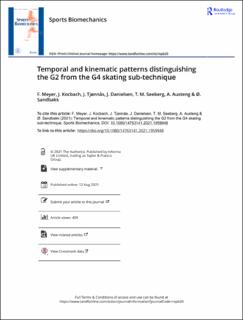| dc.contributor.author | Meyer, Frederic | |
| dc.contributor.author | Kocbach, J. | |
| dc.contributor.author | Tjønnås, J. | |
| dc.contributor.author | Danielsen, J. | |
| dc.contributor.author | Seeberg, Trine Margrethe | |
| dc.contributor.author | Austeng, A. | |
| dc.contributor.author | Sandbakk, Ø. | |
| dc.date.accessioned | 2022-02-04T09:45:30Z | |
| dc.date.available | 2022-02-04T09:45:30Z | |
| dc.date.created | 2021-08-26T16:19:05Z | |
| dc.date.issued | 2021 | |
| dc.identifier.citation | Sports Biomechanics. 2021, . | en_US |
| dc.identifier.issn | 1476-3141 | |
| dc.identifier.uri | https://hdl.handle.net/11250/2977099 | |
| dc.description.abstract | In cross-country ski skating, both the G2 and G4 sub-techniques involve one pole push for every second ski push but are used at largely different speed-slope ranges. The aim of this study was to compare temporal and kinematic patterns between G2 and G4 at both identical and different speed-slope conditions. A mixed model was used to analyse spatio-temporal parameters, while a combination of dynamic time warping and statistical parametric mapping was used to compare time traces. Main spatio-temporal parameters, such as cycle time, ski contact time and swing time, differed between G2 and G4 (all p < 0.01). Moreover, two forward and more pronounced acceleration phases of the centre of mass (CoM) were visible in G4 while only one acceleration phase was present in G2. The more continuous propulsion in G2 allows for maintaining a more constant speed at steep slopes and low speeds where this sub-technique is preferred. In contrast, the achievement of high speeds while skiing on flatter terrain seem to require more dynamic motion with shorter, more explosive propulsion periods allowed for in G4. In conclusion, G2 and G4 are two unique movements as characterised by fundamentally different CoM motion and should be denoted as two different sub-techniques. | en_US |
| dc.language.iso | eng | en_US |
| dc.publisher | Routledge | en_US |
| dc.rights | Attribution-NonCommercial-NoDerivatives 4.0 Internasjonal | * |
| dc.rights.uri | http://creativecommons.org/licenses/by-nc-nd/4.0/deed.no | * |
| dc.title | Temporal and kinematic patterns distinguishing the G2 from the G4 skating sub-technique | en_US |
| dc.type | Peer reviewed | en_US |
| dc.type | Journal article | en_US |
| dc.description.version | publishedVersion | en_US |
| dc.source.pagenumber | 18 | en_US |
| dc.source.journal | Sports Biomechanics | en_US |
| dc.identifier.doi | 10.1080/14763141.2021.1959948 | |
| dc.identifier.cristin | 1929065 | |
| dc.relation.project | Norges forskningsråd: 270791 | en_US |
| cristin.ispublished | true | |
| cristin.fulltext | original | |
| cristin.fulltext | original | |
| cristin.fulltext | preprint | |
| cristin.fulltext | preprint | |
| cristin.qualitycode | 1 | |

